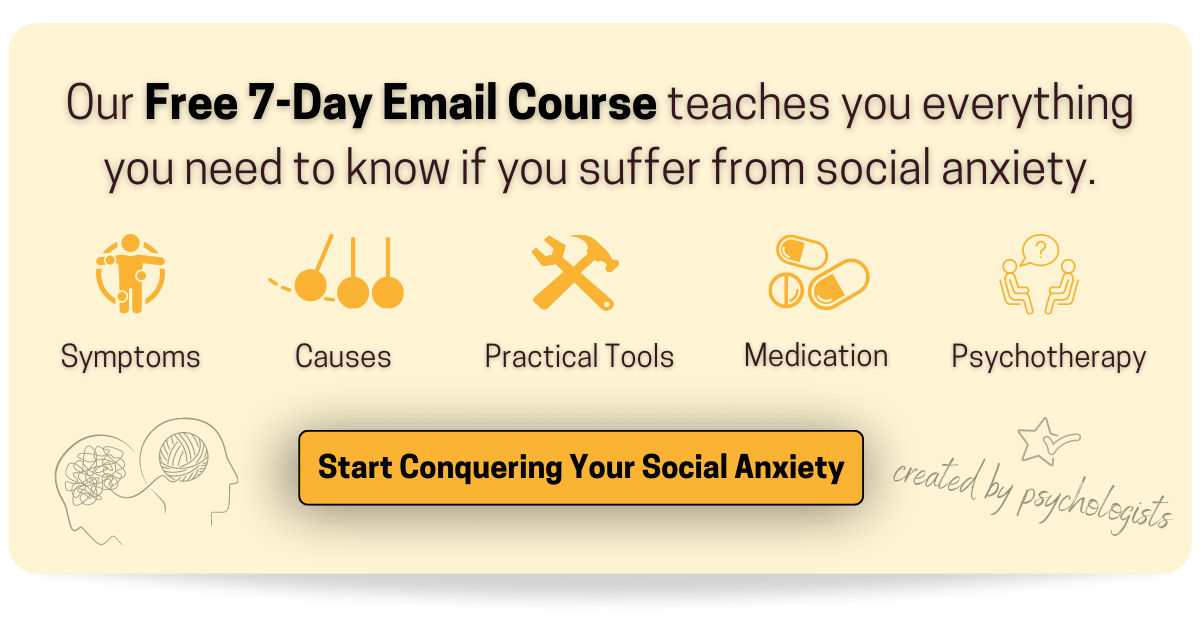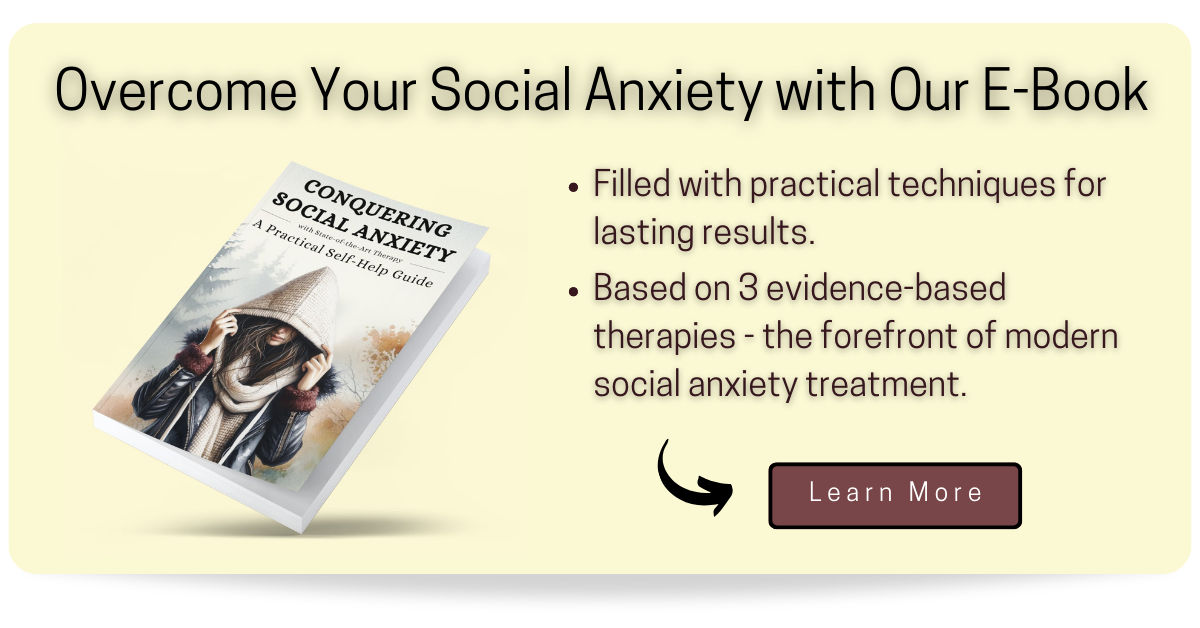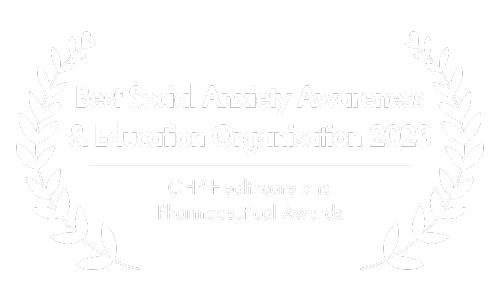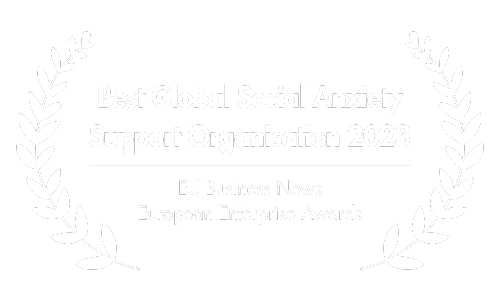The Hidden Struggles: A Detailed Guide to Social Anxiety Symptoms
This article contains recommendations for a book and an online therapy provider that help with social anxiety. Some of our links may grant you a significant discount and we may receive a commission which helps us to operate this website.
Social anxiety is more than just the occasional nervousness before a public speech or a fleeting feeling of unease in a crowded room.
It’s a profound and sometimes debilitating fear of being judged, negatively evaluated, or rejected in social or performance situations.

While many recognize the hallmark signs like avoiding eye contact or dreading public speaking, the spectrum of symptoms is vast and varied.
In this article, we aim to shed light on both the well-known and the lesser-discussed manifestations of social anxiety, providing a comprehensive understanding for those affected by it and those who wish to learn more.
To help you navigate this comprehensive guide, refer to the table of contents below. Each category is clickable, allowing you to jump directly to the topics that most interest you, ensuring a tailored reading experience.

A. Common Symptoms of Social Anxiety
Social anxiety is a complex condition that manifests in various ways among individuals. While some grapple with a broad spectrum of symptoms, others might only experience a handful.
Here’s a deeper dive into some of the most prevalent symptoms:
Constant Fear of Being Judged
At the heart of social anxiety lies the relentless fear of negative judgment or evaluation.
This isn’t just a fleeting worry but a profound fear that can overshadow daily activities.
It can lead individuals to second-guess their actions, words, and even thoughts, always wondering how they might be perceived by others.
This fear can be so overpowering that it prompts individuals to sidestep or entirely avoid situations where they feel exposed to scrutiny.

Avoidance of Social Situations
For many with social anxiety, the world can feel like a stage where they’re perpetually in the spotlight.
This intense feeling often drives them to avoid scenarios where they might be the focal point or where judgment feels imminent.
This avoidance isn’t limited to large gatherings; even smaller settings like a coffee shop or a meeting room can become sources of distress.
The avoidance often stems from a desire to escape potential embarrassment or judgment, even if such outcomes are unlikely.

Intense Worry Before Social Events
Anticipation can be a significant source of distress for those with social anxiety. The mere thought of an upcoming social event can trigger days or even weeks of anxiety and worry.
This often spirals into a cycle of sleep disturbances, obsessive thoughts about potential scenarios, and physical manifestations like stomach issues.
The anxiety isn’t just about the event itself but also about how they might be perceived, what they might say, and how they might react.

Post-Event Processing (Rumination)
Reflection is natural after any event, but for those with social anxiety, this reflection can become an intense and often negative rumination.
They might dissect every word they said, every reaction they noticed, and every gesture they made, searching for perceived errors or embarrassments.
This post-event analysis can magnify even the smallest of interactions, leading to heightened feelings of inadequacy or regret.
Physical Anxiety Symptoms
Physical manifestations are a stark reality for many with social anxiety. Symptoms like blushing, sweating, trembling, or a rapid heartbeat are not just uncomfortable but can become sources of added anxiety.
For instance, the fear isn’t just about sweating but the worry that someone might notice and judge the sweating (Schneier et al., 2012).
This added layer of meta-anxiety can further amplify the physical symptoms, creating a feedback loop of distress.

Difficulty Making and Maintaining Eye Contact
Eye contact is a fundamental aspect of human communication, signaling attention, interest, and confidence. However, for those with social anxiety, maintaining eye contact can be a daunting task.
The act of looking someone in the eye can feel intensely vulnerable, as if one is exposed to direct scrutiny.
This avoidance often stems from the fear of being perceived as inadequate or being judged based on one’s reactions.
As highlighted in a study by (Schneier et al., 2011), avoiding eye contact is a significant symptom of social anxiety, often leading to perceived social disconnect.
High Sensitivity to Criticism
Feedback, even if constructive, can be deeply threatening for individuals with social anxiety. They often perceive criticism, no matter how mild, as a direct attack on their self-worth.
This heightened sensitivity can lead to defensive responses, further withdrawal from social situations, or even avoidance of scenarios where feedback might be possible.
The underlying fear is that any criticism confirms their perceived inadequacies, reinforcing their negative self-image.

Difficulty Initiating and Sustaining Conversations
Engaging in casual conversations can become a source of anxiety for those with social anxiety. Initiating a chat might be riddled with worries about saying the “wrong” thing or being perceived as boring.
Even when a conversation is underway, there’s often a fear of awkward silences, saying something embarrassing, or not being able to hold the other person’s interest.
This constant self-monitoring can make fluid conversations challenging and draining.
Low Self-esteem and Feelings of Inadequacy
A pervasive sense of not being “good enough” often dominates the thoughts of those with social anxiety.
This isn’t just about comparing oneself to others but an intrinsic feeling of inadequacy.
Even in the absence of external judgment, individuals might judge themselves harshly, leading to a negative self-image.
This low self-esteem can further fuel avoidance behaviors, as individuals might feel they have little to offer in social situations.

Fear of Embarrassment or Humiliation
The world can feel like a minefield of potential embarrassments for those with social anxiety.
There’s a constant worry about committing perceived social faux pas, whether it’s spilling a drink, tripping, or mispronouncing a word.
This fear is often magnified, with individuals believing that any such mistake would be blown out of proportion and that they would be the subject of ridicule or judgment.

Difficulty Being Assertive
Assertiveness is the ability to express one’s feelings, opinions, and needs in a direct, honest, and appropriate way.
However, for individuals with social anxiety, being assertive can feel like an insurmountable challenge. The fear of potential conflict, backlash, or negative judgment often holds them back.
They might find themselves frequently agreeing with others, even if they hold a different opinion, just to avoid potential confrontation or to fit in.
This lack of assertiveness can lead to feelings of resentment or further reinforce their belief that their opinions are not valuable.

Over-reliance on Safety Behaviors
Safety behaviors are subtle actions or strategies employed by those with social anxiety to protect themselves from perceived social threats.
These can range from rehearsing conversations in their head, avoiding being the center of attention, to always having an escape plan when attending social events.
While these behaviors might offer temporary relief, they often reinforce the belief that social situations are inherently threatening and that one needs protection.
Over time, this can limit personal growth and the opportunity to learn that many social situations are not as threatening as perceived.

B. Unique Expressions of Social Anxiety
While many people associate social anxiety with its more general symptoms, there are several unique expressions that some individuals might specifically grapple with.
These distinctive features, though perhaps less universally recognized, can be equally debilitating for those who experience them.
It’s important to note that some people might face one or a few of these specific challenges, while others may struggle with a broader spectrum of social anxiety symptoms.
Recognizing these particular manifestations is crucial, as they provide a more comprehensive understanding of the challenges faced by individuals with social anxiety.

Glossophobia and Stage Fright: The Fear of Public Performance
Whether it’s delivering a speech, presenting a report, or performing on stage, the fear of public performance is a common manifestation of social anxiety. This fear can be categorized into two main types:
- Glossophobia (Public Speaking Anxiety): This is an intense fear of speaking in front of others. It’s not just limited to large audiences; even a small group setting can trigger anxiety. Many people with generalized social anxiety disorder experience glossophobia, but it’s also common among those without the disorder.
- Stage Fright: While it shares similarities with glossophobia, stage fright extends beyond just speaking. It encompasses any form of performance in front of an audience, such as acting, singing, or playing a musical instrument. The fear is often amplified when the performance is being evaluated by a potentially judgmental audience.
Both glossophobia and stage fright can lead to physical symptoms like trembling, sweating, a racing heart, and even nausea, which are often experienced as overwhelming (Pull, 2012).
The root cause is often the fear of negative evaluation, making mistakes in front of others, or not meeting the audience’s expectations.

Erythrophobia: Fear of Blushing
Facial blushing is a natural physiological reaction that often accompanies feelings of embarrassment.
However, when this symptom exceeds socially accepted norms, it can lead to erythrophobia, a fear of blushing.
This phenomenon is particularly common in adolescents but doesn’t always diminish with age (Laederach-Hofmann et al., 2002).
If you suffer from the fear of blushing, we recommend you click here to read our article about the topic.

Hyperhidrosis: Fear of Excessive Sweating
Hyperhidrosis, or excessive sweating, is a condition that affects many with social anxiety.
The increased sweating is often perceived as a potential reason for scrutiny, intensifying feelings of social anxiety (Davidson et al., 2002).
The exact cause, whether it’s sweat gland dysfunction or increased emotional arousal, remains a topic of study.
If you want to dive deeper into the fear of excessive sweating, you can click here to read our dedicated article.

Sexual Performance Anxiety
Closely related to stage fright, sexual performance anxiety arises from the fear of negative consequences due to perceived inadequate performance. This form of anxiety can manifest in various ways, both physically and emotionally:
- Physical Symptoms:
- Erectile Dysfunction: For men, the anxiety can lead to difficulty in achieving or maintaining an erection.
- Premature or Delayed Ejaculation: Anxiety can affect the timing of ejaculation in men.
- Vaginismus: In women, anxiety can cause involuntary muscle spasms that prevent penetration.
- Reduced Libido: Both men and women may experience a decreased desire for sexual activity.
- Difficulty Achieving Orgasm: Anxiety can make it challenging for both genders to reach climax.
- Emotional and Behavioral Symptoms:
- Avoidance of Intimacy: Due to the fear of underperformance, individuals might avoid sexual encounters altogether.
- Overthinking During Intimacy: A preoccupation with performance can prevent individuals from being in the moment.
- Low Self-esteem: Constant worry about sexual performance can erode one’s confidence and self-worth.
- Strained Relationships: The stress and tension from sexual performance anxiety can lead to misunderstandings and conflicts with a partner.
Especially in early relationship stages, the fear of not meeting a partner’s expectations can lead to anxiety, which in turn can impact sexual performance.
Over time, this can create a vicious cycle where the fear of underperformance leads to actual performance issues, further exacerbating the anxiety (Rowland & van Lankveld, 2019).

Dating anxiety revolves around the nervousness and apprehension one might feel about dating scenarios. On the other hand, heterosocial anxiety refers to the fear experienced in mixed-gender social situations.
This can manifest as nervousness during casual conversations, group activities, or even professional interactions where both genders are present.
The underlying anxiety often stems from a mismatch between the desire to impress and the fear of failing to do so (Glickman & La Greca, 2004).
Such anxieties can lead to avoidance behaviors, limiting one’s social interactions and potential relationships
Paruresis and Parcopresis: Shy Bladder and Bowel Syndromes
Paruresis, or shy bladder syndrome, and parcopresis, or shy bowel syndrome, are conditions where individuals find it challenging to urinate or have bowel movements in public restrooms due to fear of judgment (Prunas, 2013; Knowles & Skues, 2016).
This isn’t just about the act itself but the anxiety of being overheard or taking too long, leading to potential embarrassment.
These fears can be so intense that some individuals may avoid public restrooms altogether, leading to physical discomfort and further reinforcing the anxiety
Olfactory Reference Syndrome: Fear of Emitting a Bad Odor
Individuals with this syndrome are convinced they emit an unpleasant odor, even when there’s no actual smell.
This belief can lead to behaviors like excessive washing, frequent changing of clothes, or avoiding social situations altogether.
The fear is often intensified by perceived negative feedback from others, even if such feedback is imagined or misinterpreted (Pryse-Phillips, 1971; Begum & McKenna, 2011).
Over time, this can lead to social isolation and a significant impact on one’s self-esteem and quality of life.

Scopophobia: Fear of Being Stared At
Scopophobia, or the fear of being stared at, goes beyond just feeling uncomfortable under someone’s gaze.
For individuals with this fear, the sensation of being watched can trigger intense feelings of vulnerability and exposure. This can lead to a heightened state of alertness, where every glance is perceived as scrutiny (Stanborough, 2020).
The fear can be so profound that individuals might avoid public places or social gatherings to prevent being the center of attention.
The evolutionary roots suggest that being the subject of someone’s gaze can be perceived as a threat, leading to heightened anxiety and a desire to escape or hide
Bibliophobia: Fear of Reading in Public
Bibliophobia, while sounding like a fear of books, specifically refers to the fear of reading out loud in front of others.
This anxiety can stem from past experiences, such as stumbling over words during a public reading or being mocked for a mistake.

The mere anticipation of reading publicly can lead to symptoms like a racing heart, trembling voice, or even nausea.
The individual might worry about mispronouncing words, forgetting lines, or simply not meeting the expectations of the listeners.
If you are affected by bibliophobia, you can click here to read our article that discusses this fear in detail.
Scriptophobia: Fear of Writing in Public
Scriptophobia is the anxiety associated with writing in the presence of others. This can manifest in various scenarios, from jotting down notes during a meeting to filling out a form in a public place.
Individuals with this fear might be concerned about others judging their handwriting, the content of their writing, or even the speed at which they write.
Physical manifestations, like shaking hands, can further intensify the anxiety, creating a feedback loop of distress.
For this fear to be classified as a form of social anxiety, the root concern is the potential negative evaluation by onlookers. It’s not just about the act of writing, but the fear of being judged or criticized for it.

C. Coping Mechanisms and Safety Behaviors
Individuals with social anxiety often develop a range of coping mechanisms and safety behaviors to manage or avoid their fears.
While these strategies might provide temporary relief, they can inadvertently reinforce the anxiety and limit opportunities for growth and positive experiences.
Avoidance and Escape Behaviors
Many individuals with social anxiety employ strategies to either avoid anxiety-inducing situations altogether or escape them once they’re in them.
This can manifest in various ways, from declining social invitations to leaving events early.
Over time, these behaviors can limit personal experiences and opportunities, reinforcing the fear and anxiety associated with social situations.

Safety Behaviors
Safety behaviors are actions people take to reduce anxiety in social situations, often by trying to prevent a feared outcome.
Examples include rehearsing conversations in advance or always having an exit strategy.
While these behaviors might provide temporary relief, they can reinforce the belief that the feared situation is genuinely dangerous, perpetuating the cycle of anxiety.

Substance Use
Some individuals with social anxiety turn to alcohol or drugs as a coping mechanism. They hope these substances will reduce their inhibitions and make social interactions more bearable.
However, this might offer only temporary relief and can lead to a host of other problems.
Over-reliance on substances can result in dependency issues, and paradoxically, can increase anxiety levels over time, especially during withdrawal or when the substance isn’t available.

Over-preparation
Driven by the fear of negative evaluation, some individuals might excessively prepare for events or interactions.
This can involve scripting dialogues, practicing presentations multiple times, or even rehearsing simple interactions like ordering food at a restaurant.
While preparation can be beneficial, excessive preparation can become a crutch, leading individuals to feel they can’t perform without it.
Seeking Reassurance
Constantly asking for validation or reassurance is a common coping mechanism. Individuals might frequently check in with friends or family, asking questions like “Did I do okay?” or “Did I sound stupid?“
This behavior stems from a deep-seated fear of negative judgment and a desire for external validation.
However, over time, it can erode self-confidence, as individuals come to rely on others for affirmation.
Strategies to Blend In
Many individuals with social anxiety adopt strategies aimed at not drawing attention to themselves.
This can involve wearing neutral colors, avoiding any fashion that might be considered “loud” or “attention-grabbing,” or even altering their behavior to be less noticeable in social settings.
The goal is to minimize the potential for negative evaluation. However, these strategies can limit self-expression and individuality, potentially leading to feelings of invisibility or loss of identity.

While these coping mechanisms and safety behaviors might seem like effective strategies, they often prevent individuals from facing their fears head-on.
Over time, this can limit personal growth and reinforce the belief that social situations are inherently threatening.
Recognizing these behaviors is the first step towards challenging and eventually overcoming them.

D. Resources and Support
Living with social anxiety can be challenging, but it’s essential to know that support is available.
Whether you’re seeking professional therapy, self-help resources, or just a better understanding of the condition, there are numerous resources to assist you on your journey.
Tailored Online Therapy Experience
In partnership with Online-Therapy, we offer a comprehensive therapy package tailored to your needs. This platform provides:
- Weekly live sessions, with options for video, voice, or text communication.
- Unlimited messaging with your therapist.
- An 8-section CBT program featuring 25 worksheets with daily feedback.
- Additional resources, including yoga and meditation videos, a journal, activity plan, and self-assessment tests.
- The flexibility to switch therapists to find the right fit, all within a secure and confidential environment.
To focus on social anxiety, register for ‘individual therapy‘ and select ‘social anxiety‘ as your primary concern. Plans start at just $40 per week. You can sign up by clicking below to receive a 20% discount for your first month of therapy.

Workbook for Self-Guided Exercises
“The Shyness and Social Anxiety Workbook” is an invaluable resource for those looking for a structured approach to managing their social anxiety.
This workbook offers practical exercises and strategies that can complement exposure therapy exercises. You can purchase the workbook here.

E. Conclusion and Further Reading
Social anxiety is a multifaceted condition that manifests in various ways, from common symptoms like excessive self-consciousness to less common fears such as scopophobia.
Recognizing these symptoms is the first step towards understanding and managing the condition.
While the journey can be challenging, numerous resources and support systems are available to help individuals navigate their path to healing and growth.

For those looking to delve deeper into the topic, we have several related articles that provide comprehensive insights:
- Causes of Social Anxiety: Explore the underlying factors that contribute to the development of social anxiety, from genetics to environmental influences – by clicking here.
- Types of Social Anxiety: Understand the different forms and subtypes of social anxiety, offering a more nuanced view of the condition – by clicking here.
- Diagnosis of Social Anxiety: Learn about the diagnostic criteria and the process healthcare professionals use to identify and assess social anxiety – by clicking here.
- Social Anxiety Test: If you’re curious about the severity of your social anxiety, consider taking an official test to gain insights into your experiences – by clicking here.
- Introductory Guide to Social Anxiety: For a holistic overview of the condition, our in-depth guide serves as a foundational resource for understanding social anxiety’s complexities – simply click here to read it.
If you’re already familiar with the above basics of social anxiety, you might as well skip ahead to our full treatment guide. It gives you a very thorough overview of exactly what you can do to overcome your difficulties. You can read it by clicking here.

Remember, knowledge is empowering. The more you understand about social anxiety, the better equipped you’ll be to seek the right resources, support, and interventions.
You’re not alone in this journey, and with the right tools and information, a fulfilling and enriched life is entirely within reach.
Still have lingering questions? Take a step toward clarity and empowerment by enrolling in our Free 7-day Email Course. We’re dedicated to being your guide on this journey of understanding and growth.

Begum, M., & McKenna, P. J. (2011). Olfactory reference syndrome: a systematic review of the world literature. Psychological medicine, 41(3), 453–461. https://doi.org/10.1017/S0033291710001091
Davidson, J. R., Foa, E. B., Connor, K. M., & Churchill, L. E. (2002). Hyperhidrosis in social anxiety disorder. Progress in neuro-psychopharmacology & biological psychiatry, 26(7-8), 1327–1331. https://doi.org/10.1016/s0278-5846(02)00297-x
Glickman, A. R., & La Greca, A. M. (2004). The Dating Anxiety Scale for Adolescents: Scale development and associations with adolescent functioning. Journal of Clinical Child and Adolescent Psychology, 33(3), 566–578. https://doi.org/10.1207/s15374424jccp3303_14
Knowles, S. R., & Skues, J. (2016). Development and validation of the Shy Bladder and Bowel Scale (SBBS). Cognitive behaviour therapy, 45(4), 324–338. https://doi.org/10.1080/16506073.2016.1178800
Laederach-Hofmann, K., Mussgay, L., Büchel, B., Widler, P., & Rüddel, H. (2002). Patients with erythrophobia (fear of blushing) show abnormal autonomic regulation in mental stress conditions. Psychosomatic medicine, 64(2), 358–365. https://doi.org/10.1097/00006842-200203000-00022
Prunas A. (2013). La sindrome della vescica timida [Shy bladder syndrome]. Rivista di psichiatria, 48(4), 345–353. https://doi.org/10.1708/1319.14632
Pryse-Phillips W. (1971). An olfactory reference syndrome. Acta psychiatrica Scandinavica, 47(4), 484–509. https://doi.org/10.1111/j.1600-0447.1971.tb03705.x
Pull C. B. (2012). Current status of knowledge on public-speaking anxiety. Current opinion in psychiatry, 25(1), 32–38. https://doi.org/10.1097/YCO.0b013e32834e06dc
Rowland, D. L., & van Lankveld, J. J. D. M. (2019). Anxiety and Performance in Sex, Sport, and Stage: Identifying Common Ground. Frontiers in psychology, 10, 1615. https://doi.org/10.3389/fpsyg.2019.01615
Schneier, F. R., Heimberg, R. G., Liebowitz, M. R., Blanco, C., & Gorenstein, L. A. (2012). Social anxiety and functional impairment in patients seeking surgical evaluation for hyperhidrosis. Comprehensive psychiatry, 53(8), 1181–1186. https://doi.org/10.1016/j.comppsych.2012.04.009
Schneier, F. R., Rodebaugh, T. L., Blanco, C., Lewin, H., & Liebowitz, M. R. (2011). Fear and avoidance of eye contact in social anxiety disorder. Comprehensive psychiatry, 52(1), 81–87. https://doi.org/10.1016/j.comppsych.2010.04.006
Stanborough, R. J. (2020, April 16). Scopophobia: The fear of being started at. Healthline. Retrieved January 27, 2022, from https://www.healthline.com/health/scopophobia#:~:text=Scopophobia%20is%20an%20excessive%20fear,though%20you’re%20being%20scrutinized

About the Author: Martin Stork
Martin is a professional psychologist with a background in physical therapy. He has organized and led various support groups for people with social anxiety in Washington, DC and Buenos Aires, Argentina. He is the founder of Conquer Social Anxiety Ltd, where he operates as a writer, therapist and director. You can click here to find out more about Martin.



